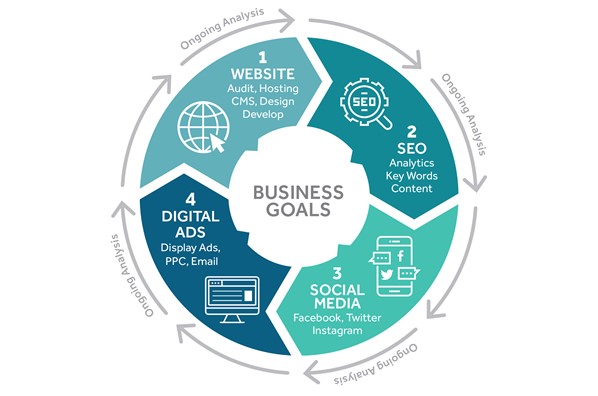How to Develop a Digital Marketing Strategy for Your Business

Focus on website, SEO, social media, and digital advertising, all build around business goals.
**Updated April 4, 2024**
In the digital era, it is essential for all businesses to have a clear digital strategy that will help grow your brand, reach your target audiences, establish an effective online presence, and accomplish business goals. Developing a digital strategy will help you surpass your competitors online.
When we work with our clients to develop a digital marketing strategy, we start with making sure they have a clear idea of their business goals and how various online tools can align with and support these goals. Then we review the following:
Website
First, we make sure our client’s website is secure, responsively designed, hosted by a reliable vendor, accessible to people with disabilities and has clear calls to action.
When developing or revising a website we recommend having the end user in mind, rather than the internal audience. This ensures that the website works for the users.
It is essential that your website loads quickly on a mobile device. According to a statistic from WebFx, “75% of users are more likely to return to a website if it’s mobile-friendly.”
If the site must be rebuilt, we usually recommend WordPress as the CMS (content management system). It’s user-friendly, customizable, and widely supported.
To ensure our clients’ digital strategy is on the road to success, it is necessary to have a web analytics service that tracks your website’s performance. Google Analytics 4 (GA4) is a free service that tracks and reports website traffic. Using a web analytics service helps us understand the users’ behavior and evaluate the website’s success.
SEO
Next, we focus on search engine optimization (SEO), because organic search is still the best way to attract customers with intent to your website. According to the Pew Research Center, 82% of US consumers research a product online before making their initial purchase. Additionally, over 90% of online experiences begin with search engines like Google or Bing.
By ranking higher on key branded terms, you have a better chance of getting the customer to click through to a page on a client’s website. Non-branded words are important too, but many of them are harder to rank for and not necessarily worth the effort. Nonetheless, every page on a website should be correctly formatted to be easily indexed and ranked by Google and Bing.
Social Media
Once we have optimized for search, we help develop a social media strategy that focuses on the right channels to reach the right audiences, because not every social network is the right fit for every business.
The steps we take to establish social media:
- Strategy: Define your business goals. What do you aim to achieve through social media?
- Audience(s): Identify the specific groups you want to reach. Who are your target customers?
- Tactics: Determine how you’ll engage with your audience. Which channels will you use, and what type of content will resonate with them?
- Voice: Consider the tone of your brand. Does it vary across different social networks?
- KPIs (Key Performance Indicators): Establish metrics to measure success on social media. What specific outcomes are you tracking?
- Resources: Assess the personnel and online tools needed to achieve your social media goals.
- Editorial Calendar: Plan your content well in advance. What topics, themes, and events will you cover?
- Monitoring and Analytic Tools: Identify the tools necessary to monitor and measure the effectiveness of your social media efforts.
Digital Ads
We often consider online advertising, which includes display ads, social media ads, email, and more. These different approaches can boost awareness, spur consideration, and drive lead generation. Of course, all of this is conducted while using actionable analytics to measure what’s working and what’s not working, and to adjust and iterate along the way.
The types of online ads we manage for clients include:
- Pay-per-click (PPC): These types of ads are meant to drive traffic to a website. The business pays the publisher (like Google) every time the ad is clicked. This kind of ad tends to generate leads for the client.
- Display Ads: These online billboards are meant to promote a product or service using visuals such as images and videos and to increase awareness.
- Social Media Ads: This paid marketing tool is used to reach and engage with key target audiences on social networks. These ads can raise awareness, foster consideration, and create conversions.
- Streaming Ads: Often called OTT/CTV ads, these are steamed while viewers are watching content on platforms like Paramount+, Peacock, or Hulu.
- Email: Delivering messages to people’s in-boxes remains an effective tool for lead generation
Pierpont works with companies of every size to develop and execute a more robust proactive digital strategy. Contact us today if you would like to speak to one of our digital experts.
Pierpont intern Isabel Chow helped revise and update this blog post.
Contact Us